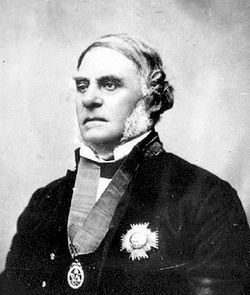Douglas Treaties
1850–1854 treaties between Indigenous peoples and the Colony of Vancouver Island From Wikipedia, the free encyclopedia
The Douglas Treaties, also known as the Vancouver Island Treaties or the Fort Victoria Treaties, were a series of treaties signed between a number of First Nations of Vancouver Island and the Colony of Vancouver Island.
 | |
| Drafted | 1850–1854 |
|---|---|
| Location | Colony of Vancouver Island |
| Parties | |
| Language | English |
Background
With the signing of the Oregon Treaty in 1846, the Hudson's Bay Company (HBC) determined that its trapping rights in the Oregon Territory were tenuous. Thus in 1849, it moved its western headquarters from Fort Vancouver on the Columbia River (present-day Vancouver, Washington) to Fort Victoria. Fort Vancouver's Chief Factor, James Douglas, was relocated to the young trading post to oversee the company's operations west of the Rockies.
This development prompted the British colonial office to designate the territory a crown colony on January 13, 1849. The new Colony of Vancouver Island was leased to the HBC for a ten-year period, and Douglas was charged with encouraging British settlement.[1] Richard Blanshard was named the colony's governor. Blanshard discovered that the hold of the HBC over the affairs of the new colony was all but absolute, and that it was Douglas who held all practical authority in the territory. There was no civil service, no police, no militia, and virtually every British colonist was an employee of the HBC.[citation needed]
Treaties
Summarize
Perspective
As the colony expanded the HBC started buying up lands for colonial settlement and industry from First Nations on Vancouver Island.[2] For four years Governor James Douglas, made a series of fourteen land purchases from First Nations.
To negotiate the terms, Douglas met first in April 1850 with leaders of the Lekwungen people (now Songhees and Esquimalt First Nations), and made verbal agreements. Each leader made an X at the bottom of a blank ledger.[3] The actual terms of the treaty were only incorporated in August, and modelled on the New Zealand Company's deeds of purchase for Maori land, used after the signing of Treaty of Waitangi.[4]
The Douglas Treaties cover approximately 930 square kilometres (360 sq mi) of land around Victoria, Saanich, Sooke, Nanaimo and Port Hardy, all on Vancouver Island, that were exchanged for cash, clothing and blankets. The terms of the treaties promised that they would be able to retain existing village lands and fields for their use, and also would be allowed to hunt and fish on the surrendered lands.[5]
These fourteen land purchases became the Douglas Treaties. Douglas didn't continue buying land due to lack of money and the slow growth of the Vancouver Island colony.[2] Along with Treaty 8, the Douglas Treaties were the last treaties signed between the Crown and the First Nations in British Columbia until Nisga'a Final Agreement.
The treaties are controversial for a number of reasons and have been subject to numerous court cases. One of the major sources of dispute regarding the treaties is the actual terms of the treaties were left blank at the time of signing and a number of clauses and pages were instead inserted at a later date.[6]
Context
The treaties were signed during a period of severe cultural destruction in which the Songhees had experienced precipitous population decline, due to the arrival of foreign diseases. The treaties remain highly controversial given that it is unclear whether the Indigenous leaders knew exactly what they were signing over.
Treaty members
| Treaty Group Name | Modern First Nation (band government) | Date | Land covered by Treaty | Money exchanged for land | Ref |
|---|---|---|---|---|---|
| Teechamitsa | Esquimalt First Nation | 29 April 1850 | Country lying between Esquimalt and Point Albert | £27 10 shillings (UK £3,714 in 2025) | [7] |
| Kosampson | Esquimalt First Nation | 30 April 1850 | Esquimalt Peninsula and Colquitz Valley | £52 10 shillings (UK £7,091 in 2025) | [7] |
| Whyomilth | Esquimalt First Nation | 30 April 1850 | Northwest of Esquimalt Harbour | £30 (UK £4,052 in 2025) | [7] |
| Chewhaytsum | Becher Bay Band | 1 May 1850 | Sooke | £45 ten shillings (UK £6,146 in 2025) | [7] |
| Chilcowitch | Songhees First Nation | 30 April 1850 | Point Gonzales | £45 (UK £6,078 in 2025) | [7] |
| Che-ko-nein | Songhees First Nation | 30 April 1850 | Point Gonzales to Cedar Hill | £79 10 shillings (UK £10,738 in 2025) | [7] |
| Sooke | T'sou-ke Nation | 10 May 1850 | Northwest of Sooke Inlet | £48 6 shillings 8 pence (UK £6,537 in 2025) | [7] |
| Ka-ky-aakan | Becher Bay Band | 1 May 1850 | Metchosin | £43 6 shillings 8 pence (UK £5,862 in 2025) | [7] |
| Saanich Tribe (South) | Tsawout First Nation and Tsartlip First Nation | 7 February 1852 | South Saanich | £41 13 shillings 4 pence (UK £5,619 in 2025) | [7] |
| Saanich Tribe (North) | Pauquachin First Nation and Tseycum First Nations | 11 February 1852 | North Saanich | [amount not stated] | [7] |
| Saalequun | Snuneymuxw First Nation | 23 December 1854 | [area not stated] | [amount not stated] | [7] |
| Swengwhung | Songhees First Nation | 30 April 1850 | [area not stated] | [amount not stated] | [7] |
| Queackar | Kwakiutl (Kwawkelth) Band | February 1851 | Fort Rupert | £64 (UK £8,645 in 2025) | [7] |
| Quakiolth | Kwakiutl (Kwawkelth) Band | February 1851 | Fort Rupert | £86 (UK £11,616 in 2025) | [7] |
References
Further reading
External links
Wikiwand - on
Seamless Wikipedia browsing. On steroids.
